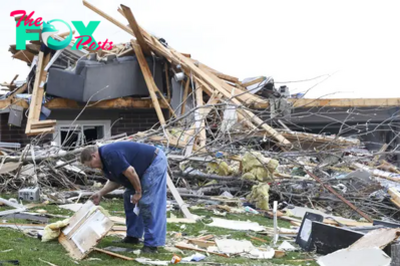US News
Scientists concerned 'rare' glacial flooding event in Alaska could happen again
Astonished scientists could not have predicted the severity of a glacial lake outburst flood that inundated a large portion of Juneau, Alaska, over the weekend.
Now, they're worried the unprecedented event could happen again.
City officials in Juneau, Alaska, issued an emergency declaration Sunday after a glacier lake outburst flood, from the Suicide Basin on the Mendenhall Glacier, wreaked havoc in the city.

Typically, researchers at the National Weather Service expect a steady flow when a break occurs from Suicide Basin, National Weather Service Juneau hydrologist Aaron Jacobs told ABC News. However, the fast-moving waters bursted out of the basin and flowed furiously through the Mendenhall River and into the Mendenhall Lake, eroding river embankments along the way.
The sheer force of Mother Nature was on full display -- and nearly difficult to fathom -- as the energy from the fast-moving waters were able to decimate hillsides, homes and 100-foot trees, Jacobs said.
MORE: Glacial break causes major flooding in Alaska, officials issue emergency declaration
How rare was the flooding event from the Mendenhall Glacier
When the Federal Emergency Management Agency created flood maps for the Mendenhall Glacier, it defined a 100-year flooding event as discharge of 17,000 cubic feet per second, and a 500-year flooding event as discharge of 20,000 cubic feet per second, Jacobs said.
The flooding that occurred on Saturday night was the result of a discharge event of about 25,000 cubic feet per second, which FEMA had previously determined had less than 1% chance of occurring, Jacobs said.
"We couldn't imagine this amount of water coming out so fast," Jacobs said.

The Mendenhall Lake level crested at 14.97 feet on Saturday around 11:15 p.m. local time, well above the previous record of 11.99 feet in July 2016.
"We haven't seen these levels, ever, in our lifetimes," Jacobs said.
Scientists at the National Weather Service will now be tracking the probability of whether the severity of the most recent flooding event could happen again, and when, so they can give the public adequate warning, Jacobs said.
MORE: Greenland Ice Sheet melting faster than previously thought, scientists say
What led to the glacier lake outburst flood
A glacial lake outburst flood occurs when a dam containing a glacial lake breaks. But Mendenhall Glacier actually gets lifted up from pressure building within the basin. So when the glacier is great enough to lift the glacier, the water escapes the basin and flows downstream, Jacobs said.
The basin fills in the summertime from snow melt and rainfall. The Suicide Glacier, which used to feed into the Suicide Basin, still hangs over it, so the melting from that ice contributes to water levels in the basin as well, Jacobs said.

The flooding destroyed several structures along the Mendenhall River, according to the National Weather Service. Two homes have been lost and another partially damaged and washed away, Rob Barr, deputy city manager of Juneau, told ABC News.
"A handful" of other residences, including a condo building were left significantly undermined," Barr said.
MORE: Antarctic sea ice has reached a record low for the year, researchers say
How researchers predict outburst floods from Mendenhall Glacier
Those in charge of monitoring the Mendenhall Glacier and the lakes within it can tell when a flooding event is gearing up, Jacobs said.
The National Weather Service in Juneau has a "well-versed" monitoring program, which involves elevation marks on Suicide Basin and a camera pointed it its direction, in order to see how much the water levels are falling and rising.

A flood watch was issued for the region on July 31, nearly a week before the break on Mendenhall Glacier occurred.
But while it is possible to monitor the water levels in the basin, it is difficult to assess just how much water is in it, Jacobs said.
Concerning flooding from the Mendenhall Glacier has been happening for over a decade
Suicide Basin has been releasing glacier lake outburst floods that cause inundation along Mendenhall Lake and Mendenhall River since 2011, according to the National Weather Service.
As of Monday morning, the Mendenhall River had returned to normal levels, between 5.5 and 6 feet, and flooding had receded, Jacobs said.
Cleanup crews are now assessing the damage and removing the debris scattered in the river and land surrounding it, Jacobs said.
The risk of flooding from melted glaciers to increase as climate warms, a study published in Nature Climate Change in 2021 found.
-

 US News44m ago
US News44m agoUkrainian-born Congresswoman Voted Against $61B Additional Aid for Her Homeland
-

 US News6h ago
US News6h agoJill Stein Calls Her Arrest at Campus Protest a ‘Bad Look’ for Washington University and Police
-

 US News6h ago
US News6h agoTornadoes Kill Four in Oklahoma as Governor Issues State of Emergency for 12 Counties
-

 US News13h ago
US News13h agoHarvey Weinstein Hospitalized After His Return to New York City From Upstate Prison
-

 US News13h ago
US News13h agoTornadoes Strike in Nebraska and Iowa, Destroying Homes
-

 US News1d ago
US News1d agoThe Only Answer to the Country’s Troubles
-

 US News1d ago
US News1d agoU.S. Government Needs to ‘Get It Right’ on Artificial Intelligence
-

 US News2d ago
US News2d agoParamedic Who Injected Elijah McClain With Ketamine Before His Death Avoids Prison



























